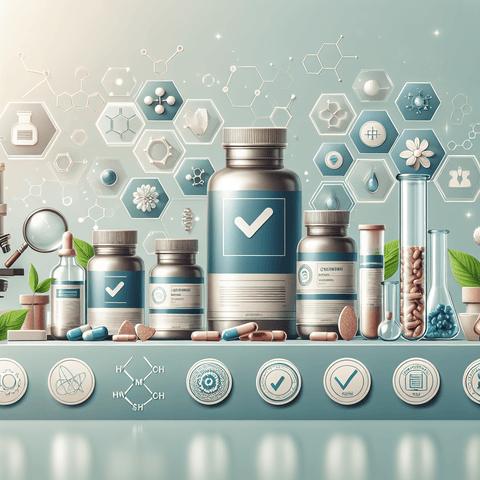Introduction
The global nutritional supplement market has witnessed explosive growth over the past few decades. According to market research data, the supplement industry is expected to exceed USD 300 billion by the year 2030, powered by increasing consumer interest in wellness, preventative health, and enhancing quality of life. With easy access to dietary supplements online and in retail stores, it has become simpler than ever for individuals to include vitamins, minerals, and herbal products in their daily routines. Yet, with opportunity comes complexity. Consumer reports and investigative studies frequently reveal discrepancies in supplement quality — from mislabeling and inaccurate dosages to the presence of harmful contaminants. Unlike pharmaceutical products, nutritional supplements are not subjected to the same pre-market scrutiny, which puts the onus on the consumer to navigate an overwhelmingly crowded and often opaque market. This is where third-party testing steps in as a critical quality assurance mechanism. Third-party tested supplements are evaluated by independent organizations unaffiliated with the manufacturer, bringing an essential layer of objectivity and accountability. These unbiased assessments of purity, potency, label accuracy, and safety provide consumers with trustworthy benchmarks when making purchase decisions. In this blog post, you’ll learn exactly how third-party testing works, what certifications and labels to look for, how to read lab results, the risks associated with unverified supplements, and why concepts like “clean labeling” and Good Manufacturing Practices (GMP) are pivotal. We will also guide you on choosing the safest, most effective supplements — whether from categories like vitamin C, vitamin D, vitamin K, magnesium, or omega-3 fish oils. This comprehensive guide will empower you to make informed, science-backed choices that support your health goals with confidence and clarity.Understanding Third-Party Tested Supplements in Nutritional Products
Third-party testing refers to the evaluation of dietary supplements by independent laboratories or organizations not affiliated with the supplement manufacturer. The purpose of these evaluations is to ensure that the supplement contains what the label claims, is free from contaminants, and meets established safety and efficacy standards. Unlike internal company testing — which may be subject to conflict of interest — third-party testing provides a more objective measurement. Nutritional supplements can undergo several types of third-party evaluations: 1. Purity testing: Ensures the absence of contaminants such as heavy metals (lead, mercury, arsenic), pesticides, microbiological pathogens (E. coli, Salmonella), and other environmental pollutants. 2. Potency testing: Confirms that the active ingredients are present at the specified strength in each serving. 3. Label accuracy: Verifies that the label reflects what is actually in the bottle. 4. Contaminant screening: Detects potentially harmful or banned substances, often particularly important in sports or weight-loss supplements. Several authoritative organizations serve as the gold standard in this space. For example, NSF International offers rigorous product certification programs and facilities audits. The United States Pharmacopeia (USP) provides USP Verified Mark certifications, which denote compliance with verified Good Manufacturing Practices and ingredient integrity. ConsumerLab, another key player, uses randomized product auditing and releases its findings directly to the public, making its reviews especially consumer-friendly. To illustrate the value of third-party testing, consider omega-3 supplements, a category known for varying EPA/DHA concentrations and vulnerability to oxidation. A supplement bearing NSF or IFOS (International Fish Oil Standards) certification has been evaluated for omega-3 content and checked for heavy metals and oxidized fats, essential for those using omega-3s for cardiovascular or cognitive support. On the flip side, products lacking these certifications may contain significantly less of the advertised ingredient or be contaminated with harmful impurities. For example, a ConsumerLab study revealed that nearly 30% of tested turmeric supplements did not meet potency or purity standards. These discrepancies highlight the importance of purchasing third-party tested products, particularly in foundational categories like magnesium or immune system support supplements such as vitamin C and vitamin D. In essence, third-party verification transforms supplements from uncertain commodities into reliable health tools — a transformation that ensures a higher standard of consumer safety and satisfaction.Supplement Quality Assurance: How to Identify Superior Products
In the supplement landscape, the term "quality assurance" signifies more than just a marketing phrase. It comprises a comprehensive framework that spans ingredient sourcing, manufacturing processes, testing, and labeling — all aimed at delivering a product that is both safe and efficacious. First, let’s focus on ingredient sourcing. High-quality supplements begin with high-quality raw materials. These materials should come from reputable suppliers who provide identity and purity documentation, often accompanied by Certificates of Analysis (COAs). Sources from controlled organic farms or marine environments, such as those producing clean omega-3s or magnesium salts, generally reflect a higher tier of supply chain integrity. Next, the manufacturing process must follow stringent protocols. The most credible manufacturers comply with cGMPs (Current Good Manufacturing Practices), a set of guidelines enforced by regulatory bodies that ensure cleanliness, batch consistency, and traceability. GMP-certified facilities maintain validated equipment, qualified staff, and rigorous internal auditing — signals that are often highlighted on the product label or company website. An equally critical aspect is label consistency. A trustworthy product clearly declares all active and inactive ingredients, serving sizes, and potential allergens or contraindications. Dosage information should align with established scientific consensus and reference values, ensuring users do not over- or under-consume essential nutrients. To further validate a brand's quality assurance protocol, savvy consumers should seek assurances and documentation. Look for statements like “Independently Tested,” “Non-GMO Verified,” or “Manufactured in a GMP-Certified Facility.” Icons and seals should be verifiable with the certifying body’s database. Shoppers should ask the following questions when evaluating a brand: - Does the product carry NSF, USP, or another recognized certification? - Is there a Certificate of Analysis available upon request? - Where are the ingredients sourced? - Are GMP standards followed? - Does the label disclose everything, including additives or fillers? For example, a product from the vitamin K category should list not just the form (e.g., K1 vs. MK-7) but also the specific microgram amount per serving and any carrier oils or excipients used. With the right scrutiny, consumers can filter out the noise and invest only in brands committed to delivering uncompromised quality, backed by scientifically validated assurance protocols.Independent Supplement Testing: Why Objective Validation Matters
One of the most critical aspects of supplement integrity is the independence of the laboratory conducting the testing. Independent verification ensures the objectivity of test results, eliminating potential conflicts of interest that may arise from in-house testing where manufacturers have a vested interest in the outcome. When a product label reads “third-party tested,” the assumption is that an autonomous, credentialed entity has evaluated the supplement according to predefined scientific criteria. These entities often follow international standards like ISO/IEC 17025 for laps and uphold transparency by sharing audit trails and publishing results with traceability and clarity. The benefits of independent testing are multi-layered: - Unbiased results represent the gold standard in consumer safety and trust. - Transparency enables customers to verify claims instead of blind acceptance. - Regulatory compliance is easier to validate with independent reports. - Brand accountability increases, compelling manufacturers to uphold best practices. Conversely, without third-party involvement, test results are at risk of being selectively published or omitted entirely. Red flags include vague statements like “tested in our lab,” no citation of the testing lab, or certifications that can't be cross-referenced with public databases. To verify a brand’s independent credentials: - Check the company’s website for COAs, batch test results, and lab names. - Visit certifying bodies’ databases like NSF or USP to confirm if the brand is listed. - Contact customer support and request lab reports or further detail on testing standards. - Examine transparency: Are test results batch-specific? Are dates and lab details provided? For instance, reputable omega-3 fish oil products often include a QR code linking to independent test results verifying EPA/DHA content and absence of oxidation indicators. Brands that exalt transparency not only enhance consumer confidence but are also poised to lead in an industry demanding greater self-regulation. When objective validation is lacking, the consumer becomes part of an experiment — a risky proposition in health and wellness. Always choose products grounded in proven, verifiable scientific rigor.Certified Supplement Safety: Protecting Your Health Through Verified Standards
The lack of stringent regulatory oversight in the global supplement market has created a double-edged sword. While consumers benefit from wide access and product variety, the risk of contamination, mislabeling, or substandard formulation is ever-present. That’s where certified supplement safety steps in as a buyer’s best defense. Unverified supplements have been routinely found to contain: - Heavy metals such as lead, arsenic, or mercury - Microbial contamination including Salmonella, E. coli, and yeast or mold - Undeclared allergens such as gluten, soy, or dairy - Pharmaceutical adulterants — especially in weight-loss, sexual enhancement, or muscle-building formulas These contaminants can lead to symptoms ranging from mild gastrointestinal distress to harmful systemic toxicity. That’s why certifications from organizations such as NSF Certified for Sport, USP Verified, or Informed-Choice exist—to establish standardized safety protocols. Certification also benefits athletes and those subject to doping regulations by screening for banned substances. Similarly, microbial and heavy metals testing adds a layer of proactive health protection, particularly important when choosing complex formulations like those in vitamin D blends that also contain co-nutrients such as magnesium or zinc. Several case studies reinforce the dangers of non-certified supplements: - An analysis published in JAMA found that over 700 negative health incidents in a year were linked to undocumented supplement ingredients. - Heavy metal contamination in Ayurvedic preparations has led to regulatory warnings and product recalls. Ultimately, a lack of certification exposes users to uncontrolled variables. Certified safety guarantees traceability, batch documentation, and consistent review of formulas to ensure safety across all production cycles.Third-Party Lab Verified Supplements: Checking the Fine Print for Lab Credentials
When a supplement claims to be “third-party lab verified,” it’s important to dig into the details of that claim. Is the lab accredited? Are the tests performed up to standard? Is the report accessible and easy to interpret? Accredited labs typically operate under ISO/IEC 17025 certification, which means they adhere to globally recognized standards for testing and calibration. This accreditation is a strong indicator of the lab's competence, impartiality, and ability to produce precise results. Here are trust indicators to look for: - Name and location of the lab - Certificate numbers and ISO status - Specific test parameters listed (e.g., heavy metals, microbial tests) - Timestamped and batch-specific COAs - Chain of custody or audit trail Consumers have increasing access to these data, especially when shopping with transparent retailers or supplement providers like TopVitamine.com. Whether you're purchasing a DHA/EPA omega-3 product or a vitamin C supplement, many listings offer downloadable lab test reports or clear certification details. When reports are available, here's how to read them: - Look for the “PASS” or “FAIL” score for each test category. - Compare listed nutrient quantities to label claims. - Review contaminant levels in ppm (parts per million) to ensure they fall below regulatory thresholds. The availability and clarity of information are as important as the results themselves. When companies make independent lab data difficult to find or conceal lab names, treat that as a ding against their credibility. Seek out brands that prioritize disclosure and uphold the science behind their claims.Clean Label Supplements: Transparency, Purity, and the Clean Movement
The clean label movement revolves around ingredient transparency and only using what’s necessary. Increasingly, consumers are demanding supplements without artificial colors, synthetic preservatives, GMOs, or allergens. A clean label may additionally signify an ethical commitment to sustainability, eco-friendly sourcing, and animal welfare. Fueling this shift is growing awareness that the efficacy of a supplement isn’t improved by substances like titanium dioxide, carrageenan, or chemical binders. These additives, though common, are unnecessary in most formulas and may pose long-term health questions. Clean label products should ideally meet the following criteria: - Free from artificial sweeteners, colors, and preservatives - Non-GMO verified - Allergen-free (e.g., gluten, lactose, soy) - Clearly labeled with every ingredient and its purpose - Preferably organic or certified naturally sourced More advanced clean labels now include sustainability practices such as marine-safe capsulation in fish oil, biodegradable packaging, or reusable bottles. These indicators, along with strong third-party testing, create a compelling commitment to both personal and environmental wellness. When choosing clean label options from magnesium or vitamin K collections, prioritize brands that explain each ingredient's role, avoid unnecessary sweeteners, and undergo third-party verification for absence of contaminants. Ultimately, a clean label should be a mark of purity and purpose — not another marketing gimmick. Independent validation, plain language disclosures, and proof of origin are how clean brands distinguish themselves from the growing field of imitators.Conclusion & Summary
The nutritional supplement industry offers an abundance of choices, but only a fraction of those products meet rigorous standards of quality and safety. With growing concerns surrounding contamination, mislabeling, and ineffective formulations, it is more important than ever to make informed purchasing decisions. Third-party tested supplements stand out as the gold standard in this environment. By undergoing independent evaluation for purity, potency, and contaminants, these products provide peace of mind and evidence-based assurances. Certifications from respected bodies such as NSF, USP, and ConsumerLab further affirm product integrity, while clean label commitments ensure toxic-free transparency in their everyday forms. As you explore your options — whether from categories like vitamin D, omega-3 fish oils, vitamin C, or magnesium — use the guidance provided in this article to look past decorative labels and focus on scientific credentials. TopVitamine.com is dedicated to offering only premium supplements that comply with these highest third-party testing and quality assurance standards. Take charge of your wellness journey — shop responsibly, read test results, and verify certifications.Q&A Section
Q1: What is third-party testing in supplements?Third-party testing means an independent laboratory has tested a supplement for criteria like purity, potency, and contaminants to ensure it meets its label claims and safety standards. Q2: Are third-party tested supplements better?
Yes, they significantly increase the trust and reliability of the supplement. Products that are independently tested are less likely to contain harmful substances or be mislabeled. Q3: How can I tell if a supplement is third-party certified?
Look for certification logos like USP Verified, NSF Certified, or Informed-Choice. These should be verifiable through official websites or batch-specific lab reports. Q4: What are the risks of non-certified supplements?
These can include contamination (e.g., heavy metals), false ingredient claims, banned substances, allergens, and ineffective dosages that lead to health risks or no benefit. Q5: Where can I buy third-party certified supplements online?
TopVitamine.com offers a wide range of independently tested supplements from premium brands, including options for vitamin K, omega-3, and magnesium.



